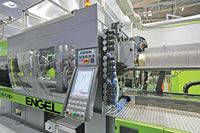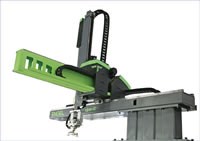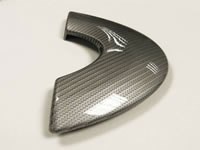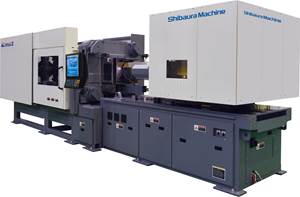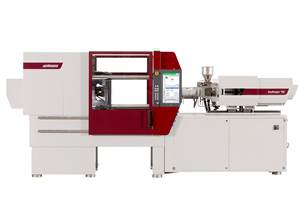New Presses, Robots & Process Tech To Debut at K 2010 Fair
The exhibit of Engel Austria at October’s K 2010 fair in Dusseldorf, Germany, will host a wide range of product introductions, ranging from new machines for caps/closures and micromolding to a new model of small electric press, a new generation of beam robots, and developing process technologies for polyurethane skin coating, machine-integrated mold-temperature control, multi-shot optical molding, and all-plastic “hybrid” composites.
The exhibit of Engel Austria at October’s K 2010 fair in Dusseldorf, Germany, will host a wide range of product introductions, ranging from new machines for caps/closures and micromolding to a new model of small electric press, a new generation of beam robots, and developing process technologies for polyurethane skin coating, machine-integrated mold-temperature control, multi-shot optical molding, and all-plastic “hybrid” composites. Engel (parent of Engel Machinery, Inc., York, Pa., engelglobal.com/na) previewed all these developments at a recent press conference at its Schwertberg headquarters.
ALL-ELECTRIC CAP MOLDING
Perhaps the biggest announcement was Engel’s new e-cap system, which it describes as the first fully electric system for cap and closure molding, designed to cut energy consumption in half while providing speed competitive with standard accumulator-assisted hydraulic cap-molding systems. It has a new injection unit capable of high plasticating rates and high-speed, high-pressure injection—up to 300 mm/sec at 29,000 psi in the “premium” version. The machine also has increased ejector force. The first model will be 420 metric tons, reportedly capable of molding 26-mm “short” soft-drink caps in 96 cavities on a 2.6-sec cycle.
Another new development for K 2010 is a micromolding system utilizing a new all-electric injection unit for Engel’s smallest tiebarless machines—either the e-victory hybrid (28 m.t.) or e-motion all electric version (55 m.t.). The single-stage injector has a 15-mm screw that can handle standard pellets and provides short residence times and first-in/first-out performance. This unit is designed for shot sizes down to 1 g and part sizes down to 0.1 g. It is not intended for the very smallest part weights on the order of 0.01 g.
Engel also added a 100-m.t. model to its e-motion T line of all-electric tiebar presses. Previously, the range was 180 to 500 m.t.
NEW ROBOT GENERATION
At K, Engel also plans to show off its new “viper” all-servo robots. The viper 40 model came out last fall and the viper 20 this past March. The viper 60 arrives this summer. The model numbers correspond to the payload capacity in kg for the “normal” model—there are also “speed” and “load” versions with lower and higher capacities, respectively. These units were redesigned to minimize moving parts and to use laser-welded steel beams in place of aluminum, providing a higher stiffness-to-weight ratio. New software provides three automatic functions:
- “Efficiency control” saves energy by optimizing the robot’s speed relative to the cycle time. In other words, the robot travels no faster than necessary in order to “reach its position at the right time,” according to Dr. Georg Steinbichler, v.p. of R&D.
- “Mass identification” measures the electric motor current to identify the mass of the robot’s payload and adjusts the motor’s dynamic values to achieve the needed acceleration.
- “Vibration control” also uses automatic mass sensing to anticipate and damp vibrations.
OVERMOLDING PUR SKINS
The concept of combining thermoplastic injection molding with two-component thermoset polyurethane reaction injection molding (RIM) is apparently gaining in popularity. This approach was demonsrated at the last two K shows by KraussMaffei Corp. (kraussmaffei.com) and has been used to mold soft-touch skins on rigid supports for auto interior parts. Engel will bring out its own version, called “clearmelt,” which is aimed at a different sort of auto interior application. In this case, the rigid thermoplastic support will be back-molded onto an in-mold film with a metallic or other decorative surface—or even a functional surface such as printed flexible circuitry for capacitive sensor systems. In the next machine cycle, the mold turntable will index the part to a new position where a very thin, clear PUR coating will be molded over the front side of the decorative film to provide scratch protection. Engel is working with German PUR machinery supplier Hennecke to integrate the two-component PUR mixing/dispensing system with the Engel injection machine.
An alternative application of this combination technology is to use the part-removal robot to dispense a foam-in-place PUR seal or gasket onto the thermoplastic part after demolding.
PROCESS INNOVATION R&D
At the show, Engel also plans to highlight its ongoing research into several areas of processing. One of these is called “machine-integrated mold cooling.” According to Dr. Steinbichler, Engel found new temperature sensors whose small size allows them to be installed in the mold very close to the inner surface. This allows software embedded in the machine controller to automatically regulate coolant flow and temperature throughout the cycle to maintain the desired temperature within 2° C.
Engel continues to investigate process alternatives for optical parts molding. One unusual approach is to use a multilayer injection molding on an Engel combi machine to produce thick lenses in three layers—of the same material. Because a thick lens would take a long time to cool, it would speed the process to mold a core layer and then overmold two thin outer layers.
Another developmental technology to be highlighted at the K show is lightweight automotive design with formed sheets of continuous-fiber thermoplastic composites. Engel and other companies are exploring a new generation of all-plastic “hybrid” composites as successors to current metal-plastic hybrids made by overmolding stamped sheet metal. According to Engel’s concept, thermoplastic sheets reinforced with glass or carbon fiber fabric would be loaded into an injection mold and heated. Then the mold would close to form the sheet into a 3D shape. In addition, thermoplastic melt would be injected at particular locations onto the surface of the formed sheet to create stiffening ribs, attachment points, etc. Those ribs could be hollowed out with gas or water assist to minimize weight. Use of structural foam in the ribs would be another possible approach.
Related Content
Compact Solution for Two-Component Molding
Zahoransky’s new internal mold handling technology foregoes the time, space and money required for core-back, rotary table or index plate technologies for 2K molding.
Read MoreCompletely Connected Molding
NPE2024: Medical, inmold labeling, core-back molding and Industry 4.0 technologies on display at Shibaura’s booth.
Read MoreSecondary Injection Unit Provides Primary Benefits for Molder
Core Technology Molding turned to Mold-Masters E-Multi auxiliary injection unit to help it win a job and dramatically change its process.
Read MoreFakuma 2023: Wittmann Battenfeld Expands All-Electric Line, Direct-Current Capabilities
Wittmann Battenfeld will introduce the new EcoPower B8X injection molding machine line and show direct current as an energy source for a concept machine that will power its own robot.
Read MoreRead Next
People 4.0 – How to Get Buy-In from Your Staff for Industry 4.0 Systems
Implementing a production monitoring system as the foundation of a ‘smart factory’ is about integrating people with new technology as much as it is about integrating machines and computers. Here are tips from a company that has gone through the process.
Read MoreMaking the Circular Economy a Reality
Driven by brand owner demands and new worldwide legislation, the entire supply chain is working toward the shift to circularity, with some evidence the circular economy has already begun.
Read MoreSee Recyclers Close the Loop on Trade Show Production Scrap at NPE2024
A collaboration between show organizer PLASTICS, recycler CPR and size reduction experts WEIMA and Conair recovered and recycled all production scrap at NPE2024.
Read More




